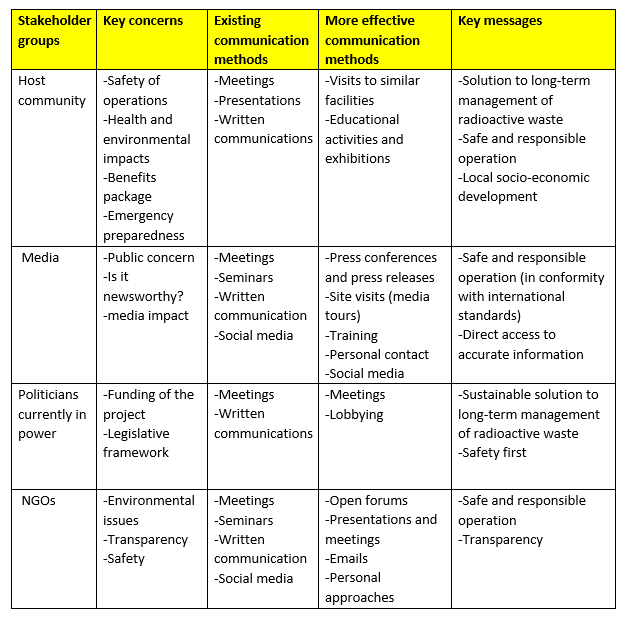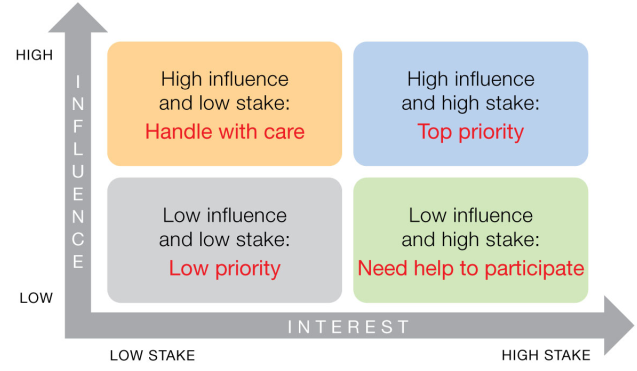As part of the development of any communication strategy or plan, it is essential that stakeholder analysis is carried out at an early stage. Two different tools can be used: stakeholder matrices and stakeholder maps.
Different audiences have a range of different concerns, levels of knowledge and experience on nuclear issues. This calls for communication at different levels of technical detail, via different channels. Audiences, or stakeholder groups, may also vary from country to country.
To communicate in the most effective way, it is important to know who the audiences are for a project or objective. Stakeholder types are readily identifiable for nuclear concerns, while stakeholder mapping and prioritisation helps programme leaders customize their outreach and assess what will work best for their culture, context and situation.
A stakeholder is any individual or organisation affected by the project or that can have an impact on it. A stakeholder may have direct or indirect interest in the project activities, and may be in contact with it daily, or just occasionally. Stakeholders can be heterogeneous (e.g. local community: families, employees, local political organisations, politicians, local and national NGOs, etc). The power/interest matrix for stakeholder prioritization is a practical tool set out below, which users of the toolbox may adapt to their specific needs.
Stakeholder interests may not only be different, they may also be in conflict with each other. For example, there will be differences between the aspirations and concerns between those already involved in the nuclear industry and those in the local community around an existing facility, or even those not around the facility in the case of a new programme etc. For example, the local mayor may be in favour of the facility, but doesn’t want to lose the political support of local opponents.
Having identified broad groups of stakeholders, the next stage is to understand their interests and what motivates them.
It is also helpful to consider their potential influence on the project or plan:
- What is their personal and professional background and what is the reason for their participation?
- What is their source of influence or power? Are they elected representatives? Are they important from a business or employment perspective?
- Who can they influence and who influences them?
- How do they use that influence or power?
- What are the relations among stakeholders? Who cooperates with whom, who is in a conflict with whom?
Stakeholder Matrix
Based on this analysis, a stakeholder communication matrix can be developed describing the following, in terms of each of the identified stakeholders:
- Key concerns
- Existing communication methods (tools and channels)
- More effective communication methods
- Key messages
- Who can help
It is possible to recognise general stakeholder groups in terms of these questions concerning their possible influence. These various stakeholders have different perceptions and concerns regarding a particular project or proposal, and this will influence how to communicate with them.
Concerns | Related questions |
Legal | Is the process supported by laws; do they trust the actors? Is the regulator applying laws, etc. correctly? |
Ethical | Is this a burden on future generations? Is the project unfairly targeting poor communities, indigenous groups, etc.? |
Economic | What’s in it for them (benefits)? Will it destroy businesses or local tourism etc. (disadvantages)? Is this a correct use of funds by government? |
Technological | They may not trust the concept or technology. They may believe there are too many uncertainties. They may fear nuclear, especially waste. |
Societal | Opponents will not want to follow the nuclear path, preferring other energy sources. Supporters will not want to let the lights go out; they will trust the technology. |
Ecological/Environmental | What impacts will there be on local wildlife? Will construction destroy the environment with impacts from dust? What about health, safety, transport? |
Political | What will be the cost to the national budget? This development was not in the local plan. This is not their party’s policy. Can such decisions be left to politicians, not the people? Project timescales are longer than term of office. |
This table shows an example of a stakeholder matrix for a radioactive waste repository in terms of the key stakeholders:

Stakeholder Mapping
Stakeholder mapping involves the identification of the interested parties, their interests, possible impacts and influences and the ways in which they interact between themselves or within the process. Typical examples of target groups include formal and informal representatives who are, or could be, affected by the activity, such as authorities, politicians, media, local citizens, local representatives, opinion leaders, pressure groups, neighbouring countries, employees, scientists and specialists, young people and so on.
For each of the relevant target groups, as part of the stakeholder mapping, it is important that we understand their knowledge and initial opinion about the project or activity, as well as their attitudes and behaviour, so as to be able to communicate with them. We need to recognise what should be addressed in the opinion of the target groups in order to meet the goals of the project or activity. Also, it is of benefit to identify those who could be allies or partners in the communication activity. Based on the results of the stakeholder mapping, appropriate communication approaches can be developed for each of the groups.

Stakeholder maps can be created using online applications.
Market Research
In nuclear communication, market research specifically refers to the development of an understanding of the views, attitudes and concerns of the full range of stakeholders impacted by nuclear activities. This is another way of evaluating the effectiveness of your activities.
Evaluation and assessment after each individual communication activity, especially meetings, workshops and similar events, can be achieved with questionnaires and online response forms, this can include the use of opinion polls and surveys both nationally and locally.
Opinion surveys and research also help to identify issues for addressing and provide an indication of priorities (i.e., understanding the level of knowledge and opinions of the public and stakeholder groups regarding the project).
It can be helpful to undertake regular polling during the implementation of a communication plan. This not only gains an understanding of the acceptability of the tools and channels being used, but also aids evaluation of the impact of the messages being communicated. Use caution to ensure that those polled or surveyed represent a cross-section of the intended audience for the communication activities, or a misleading view of concerns can be obtained.
To understand how stakeholder views and concerns can be altered with specific information, a related technique, deliberative polling, is also often employed. This employs social science to determine what people would think about an issue if they became more engaged and informed. A random, representative sample is first polled on some specific topic. After this baseline poll, members of the sample are invited to gather at a single place for one or more days to discuss the issue. Carefully balanced briefing materials developed by an all-partisan advisory group are sent to the participants and are also made publicly available. The participants engage in dialogue with competing experts and decision makers based on questions they develop in small group discussions with trained moderators. After the deliberations, the sample of citizens is again asked the original questions. The resulting changes in opinion represent the conclusions the public would reach if they had an opportunity to truly deliberate about an issue, engage with alternative points of view, and become more informed.